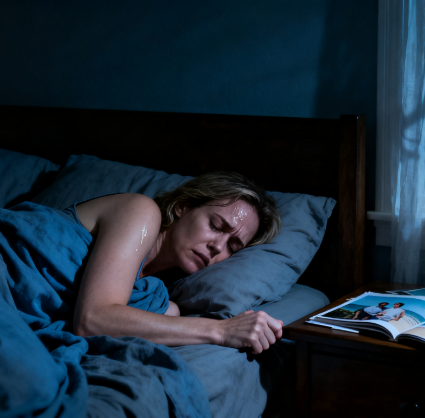
The dreams started subtly. A restless shift in the night, a muffled gasp you’d mistake for a snore. But over time, they became more frequent, more intense. She’d wake with a jolt, her heart hammering against her ribs, her skin clammy. “It’s nothing,” she’d whisper, “just a bad dream.” But the pattern was undeniable. The nightmares began the same week you’d returned from the family beach vacation and uploaded the photos to the cloud.
You’d written it off as stress, the lingering exhaustion of travel. But one night, after she bolted upright in bed, trembling, you held her and asked, “What is it? What are you seeing?”
Her voice was a small, broken thing in the dark. “Water. It’s always water. I’m… drowning.”
The next morning, you looked at the vacation photos with new eyes. There you all were, smiling on the sand. The kids building a castle. You waving from the surf. And there was she, standing ankle-deep at the water’s edge, a smile plastered on her face that didn’t quite reach her eyes. In every single picture near the ocean, she was in the same place, never going deeper.
A cold suspicion, entirely new and terrifying, began to form. The dreams, the photos… they weren’t about the water. They were about a memory in the water.
You didn’t ask her. You called her mother. The conversation was halting, awkward. And then, her mother broke down. “She never told you? I made her promise never to tell.”
The story she told you was one from a summer forty years ago. A six-year-old girl, wading too deep. A rogue wave. The terrifying, silent struggle under the churning foam. The lifeguard who pulled her out, blue-lipped and choking. The way her father, ashamed of his momentary lapse in supervision, had sworn the whole family to secrecy. “We don’t talk about it,” became the family motto. “It never happened.”
She had carried the ghost of that little girl inside her for four decades, a silent, terrified child who never learned to swim, who learned instead that the world was a place where you smile on the beach and never, ever admit you’re drowning.
She’s been dreaming about drowning ever since the family vacation photos were uploaded because your happy, sun-drenched memories were a lie she could no longer silently sustain. Seeing the visual proof of her own fear, displayed so cheerfully for everyone to see, broke the dam. The dreams weren’t a new fear; they were an old, buried trauma finally screaming to be heard, using the only language it knew—the language of water and panic and a little girl fighting for air.
That weekend, you didn’t say a word. You simply drove her to the local community pool. You walked her to the shallow end, held her hands, and said, “We’re not here to swim. We’re just here to get our feet wet. For as long as you want.”
She stood there, trembling, tears mixing with the chlorinated water on her cheeks. It was the first step. The dreams didn’t stop that night, or the next. But they became less frequent. She was no longer drowning alone in the dark. She was learning, forty years late, that it was safe to stand in the water, and safer still to finally, finally, talk about the wave.